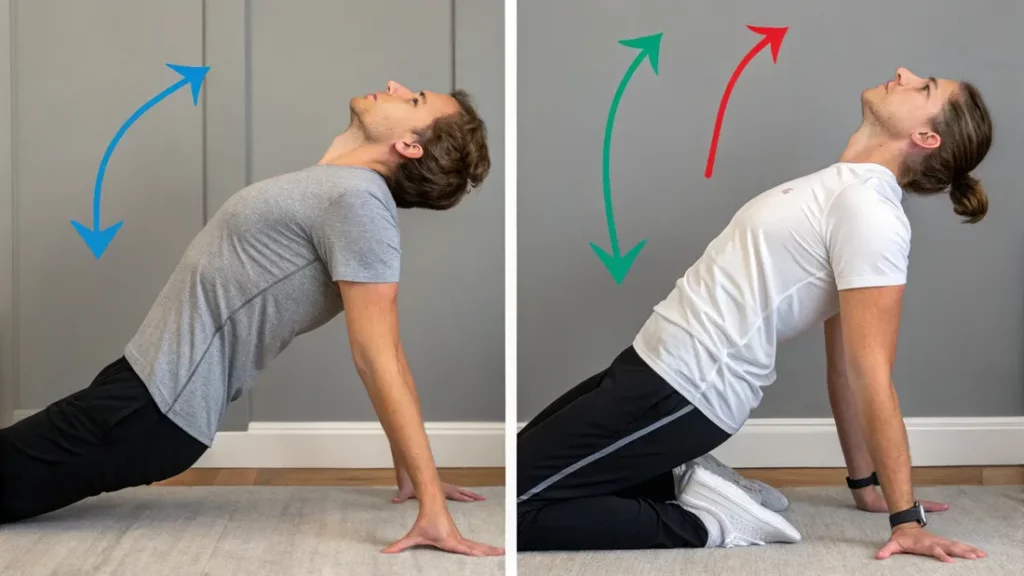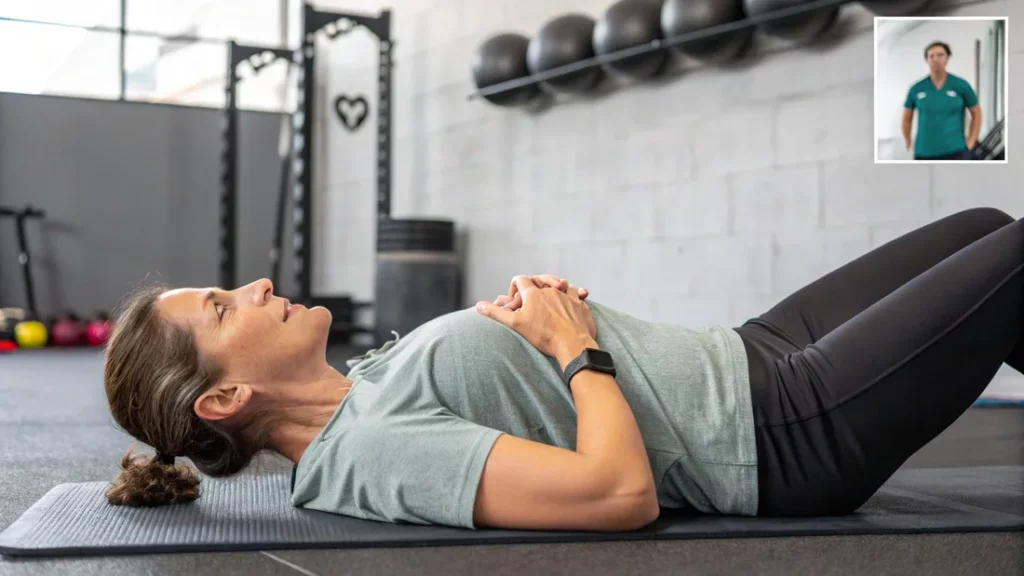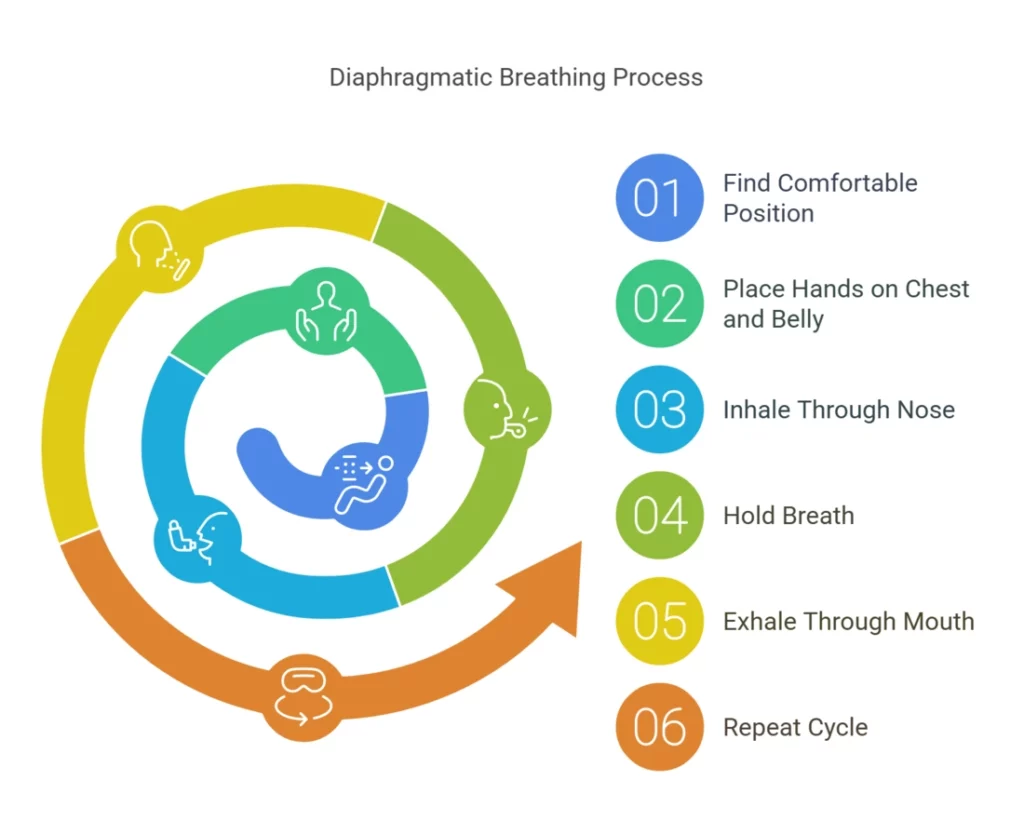Are you looking to take your workout performance to the next level?
Many often overlook a vital element – diaphragmatic breathing.
Often called “belly breathing,” this technique can dramatically improve your workouts by optimizing your breathing and making each breath more effective.

In this post, you’ll find a step-by-step guide to diaphragmatic breathing, and you’ll also learn how this method has helped me to transform my own workouts.
I’ll also be sharing a recommendation on a trainer that I have found to be invaluable.
Let’s dive in and discover the power of diaphragmatic breathing for workouts!
What Is Diaphragmatic Breathing (Belly Breathing)?
Before diving into the “how,” let’s explore the “what.”
Diaphragmatic breathing, often called “belly breathing,” is a natural way to breathe that maximizes lung capacity and promotes relaxation.
It differs dramatically from shallow chest breathing, which we often do unconsciously.

Key Points
- What It Is:
- Belly Breathing: Diaphragmatic breathing is so-called because it involves expanding your belly as you breathe.
- Diaphragm Engagement: It primarily uses your diaphragm, a large muscle located at the base of your lungs.
- Deep Breathing: This method promotes a deeper, fuller breath, which allows for better circulation.
- How it Differs from Shallow Chest Breathing:
- Chest Breathing: Shallow chest breathing uses your chest and shoulders, rather than your diaphragm, to take shallow breaths, which do not fully use the lungs, and also often increases tension.
- Tension & Strain: This method often results in tension and strain and limits the amount of oxygen that enters the body.
- Inefficiency: Chest breathing is an inefficient method that prevents your body from receiving the optimal level of oxygen.
- Benefits of Diaphragmatic Breathing:
- Increased Oxygen Intake: Diaphragmatic breathing helps to increase oxygen intake, which is vital for workout performance and recovery.
- Improved Blood Flow: Deep breaths from diaphragmatic breathing improve blood flow, which will help with the overall functionality of the body.
- Enhanced Lung Capacity: This method maximizes your lung capacity, which helps you to breathe more effectively, and to take on more oxygen.
- Greater Relaxation: The movement of the diaphragm also allows you to enter a state of greater relaxation which helps to reduce stress and improve your performance.
How I Discovered the Benefits of Diaphragmatic Breathing
While the science of diaphragmatic breathing is fascinating, learning about how others have applied this knowledge to their lives can often be even more insightful.
In this section, I’ll share the personal experiences that led me to incorporate diaphragmatic breathing, and the ways that it has transformed my workouts.

Key Points
- Initial Struggles:
- Like many, I was initially unaware of the importance of proper breathing. My workouts were often plagued by fatigue, shortness of breath, and a general feeling of strain and tension.
- This feeling made me seek an alternative method, and is what set me on my path to discovering the importance of diaphragmatic breathing.
- Discovering Diaphragmatic Breathing:
- After doing some research, I found that many athletes swear by diaphragmatic breathing and how it has transformed their workouts. That’s where I decided to learn more about this method.
- I started to explore the world of breathwork, and realized how little I had paid attention to my breathing during workouts. I was fascinated by how a simple change could make a huge difference to my workouts, and this led me to focus my efforts specifically on this breathing method.
- First Experiences & Discoveries:
- The first time I tried diaphragmatic breathing, I felt an immediate difference. My body instantly relaxed and I was able to focus more effectively on the exercise that I was doing.
- My workout sessions became more enjoyable, my breath became deeper, and my performance improved significantly. It was after this experience that I knew it was a method I would be adding into my daily routine.
- This led me to understand the need to be mindful, which is something that I still focus on today. I also realized that breathing is an integral part of my workout journey, and it is something that I need to fully understand and respect.
A Step-by-Step Guide to Diaphragmatic Breathing
Now that you understand the importance of diaphragmatic breathing, it’s time to learn how to do it.
This method is a very natural way to breathe, and with practice, it will become a part of your daily routine.
Let’s go through the steps together, and you can start to implement this method for yourself.

Step-by-Step Instructions
- Step 1: Find a Comfortable Position:
- Begin by finding a comfortable position. You can lie on your back with your knees slightly bent, sit upright in a chair, or even stand. The key is to choose a position where your body feels relaxed and at ease.
- Step 2: Place Hands on Chest and Belly:
- Place one hand on your chest and the other hand on your belly, just below your ribcage. This allows you to feel your body’s movement as you breathe and is essential for ensuring that you are performing this method correctly.
- Step 3: Breathe In Through Your Nose:
- Inhale slowly and deeply through your nose. As you breathe in, focus on pushing your belly outwards, which will help to activate your diaphragm. Your chest should remain relatively still during this step.
- Step 4: Hold the Breath:
- After you have fully inhaled, hold your breath briefly for a couple of seconds. This will allow the oxygen to travel throughout your body.
- Step 5: Exhale Through Your Mouth:
- Exhale slowly and gently through your mouth, allowing your belly to fall. This will signify that the diaphragm has done its work, and will release any tension from the body.
- Step 6: Repeat:
- Repeat this breathing cycle for 5-10 minutes, or as long as needed. Overtime this method will become more natural, and you can implement it into your daily routine.
How Diaphragmatic Breathing Enhances Your Workouts
Now that you know how to perform diaphragmatic breathing, let’s dive into the real-world benefits that this technique can bring to your workouts.
It’s not just about feeling more relaxed; it’s also about how this method can make your workouts more effective and enjoyable.

Key Benefits
- Improved Stamina:
- By using diaphragmatic breathing, you can ensure that your muscles are receiving enough oxygen. This increased oxygen supply helps to reduce fatigue and improve your overall stamina, allowing you to push yourself further and for longer during your workouts.
- Conserved Energy:
- This technique allows you to use your breath more efficiently. By using your diaphragm, you are using a larger muscle to draw in more air, which means that you need less energy.
- This can help you to conserve energy during your workouts, and also improve your overall performance.
- Enhanced Muscle Oxygenation:
- The full deep breaths that you take during diaphragmatic breathing helps to improve blood flow, and also assists in delivering more oxygen to your muscles. This is vital to help reduce soreness and increase recovery.
- This enhanced oxygenation will lead to better muscle performance, and also faster recovery after exercise.
- Enhanced Performance:
- The above benefits help to contribute to overall workout performance. By using diaphragmatic breathing, you can push yourself further, reduce the risk of injury, and increase overall performance.
- This method is useful for anyone who is looking to improve their workouts and achieve greater fitness goals.
- Improved Core Stabilization:
- Diaphragmatic breathing is great for improving your core, as it helps to fully engage the core muscles, which helps to stabilize the torso during exercise.
- This helps to make all of your movements more efficient, and will help to reduce the risk of injury. This will also improve overall strength and flexibility.
- Reduced Stress:
- This technique can help you to enter a state of greater relaxation, and reduce the amount of stress hormones in the body.
- By reducing stress, you are placing your body in a better position for overall wellbeing, improved workouts and better recovery.
Real-Life Examples
To give you a better understanding of how this method can be implemented into your daily routine, I have listed some examples.
For example, diaphragmatic breathing is a great method for those who are looking to improve their stamina during long runs, for those who are wanting to perform weightlifting effectively, or for those who are wanting to get through high-intensity training with more efficiency.
These are just some of the examples, and it can be used for all types of workout performance improvements.
Choosing The Best Diaphragmatic Breathing Trainer
While diaphragmatic breathing can be done without any special equipment, some individuals may find that a breathing trainer can enhance their practice, and make it easier to achieve more effective results.
A trainer may provide you with added resistance or specific guidance, which is especially useful for beginners.
Let’s delve into why a trainer may be helpful, and the main things to look out for when making a purchase.”
Why a Trainer is Helpful
- Improved Breathing Capacity:
- A breathing trainer can assist you in improving your overall breathing capacity, which is especially useful for those who struggle to take full breaths. The trainer will help you to challenge your lungs to work harder, which will improve their strength and flexibility.
- Consistent Practice:
- A trainer provides a consistent and measurable way to practice, and it will also help you to track your progress overtime. This may help you to better reach your fitness goals and improve your overall health.
- Guidance and Support:
- For beginners, a breathing trainer can provide the guidance that is needed to ensure that you are performing your breathing exercises with the correct form, and that you are not straining your body. It can also be used by advanced athletes to help take their training to the next level.
Key Considerations When Choosing a Trainer
- Adjustable Resistance:
- An adjustable resistance is key, as this allows you to adjust the intensity of your training as you progress. This feature will help you to challenge your lungs effectively and allow you to adapt the difficulty to your individual needs.
- Ease of Use:
- Choose a trainer that is easy to use, and that is also quick to set up. A simple and easy-to-understand design makes your training more accessible and more enjoyable.
- Comfort:
- Comfort is an important factor to consider, as it will affect how often you use the product. Make sure the mouthpiece is comfortable, and that it does not cause any irritation. This will make the overall practice more comfortable and enjoyable.
- Portability:
- Choose a breathing trainer that is lightweight and easy to transport. This will allow you to do your breathing exercises anywhere, at any time. This is especially useful for those who travel often.
- Durability:
- Ensure that you are buying a breathing trainer that is well made and is durable so that it will last for years to come. Check reviews and ensure that the product is reputable, and from a well-known brand.
Product Recommendation

Based on my research and experience, I recommend the POWERbreathe Kinetic Breathing Trainer, as it has adjustable resistance, is easy to use, is comfortable, portable and very durable.
It has greatly enhanced my diaphragmatic breathing practice and I find it to be invaluable in improving my lung strength and breathing capacity.
It has been a great tool in my fitness journey, and I would highly recommend it to anyone who is seeking to further improve their breathing.
Practical Tips for Implementing Diaphragmatic Breathing
Now that you know why and how to perform diaphragmatic breathing, let’s explore some practical tips that will help you integrate this technique into your daily life.
Remember that the aim is to make this a sustainable part of your routine, and not just a short-term change.
These tips will help you in your journey!
Key Tips
- Start Slowly:
- When you are starting out, make sure to begin slowly and do not push yourself too hard too soon. Begin by practicing in a quiet space where you can be fully present and focused. It is also useful to set a time limit so you can learn the basics of this method.
- As you get more comfortable, you can gradually increase the length and intensity of your sessions, as well as integrating this method into your workouts.
- Be Consistent:
- Consistency is key to improving your overall technique and obtaining the best results. Try to make diaphragmatic breathing part of your daily routine, to ensure that you are getting all of the amazing benefits.
- Whether you choose to do it before bed, after your workouts, or just whenever you feel like it, be sure to do it consistently and you will feel the difference.
- Be Patient:
- Be patient with yourself, and understand that you will not become an expert overnight. It takes time to fully understand and perfect this technique, but with focus and patience, you will get there.
- You should also try to be mindful, present, and focus on your breathing, to fully enjoy the process, and to ensure you are doing it correctly.
- Use a Trainer Where Appropriate:
- If you are wanting to take your practice further, a breathing trainer can be very helpful. A breathing trainer helps you to better engage with your diaphragm and will also provide resistance to help strengthen your lungs and diaphragm.
- A trainer can provide further guidance and support on your journey, and will help to improve your breathing even further.
Frequently Asked Questions About Diaphragmatic Breathing
To ensure you have a solid understanding of diaphragmatic breathing, let’s address some of the most common questions that people have.
By answering these questions, you will have a more thorough understanding of this breathing technique, and be ready to implement it in your daily life.
- Question 1: What is the difference between diaphragmatic breathing and chest breathing?
- Answer: Diaphragmatic breathing, or belly breathing, involves using your diaphragm, a large muscle at the base of your lungs, to take deep breaths. As you inhale, your belly rises, and your chest remains relatively still. Chest breathing, on the other hand, uses your chest and shoulders to take shallow breaths, rather than your diaphragm. This shallow breath does not fully fill the lungs and does not provide the same benefits as diaphragmatic breathing.
- Question 2: How does diaphragmatic breathing improve my workout performance?
- Answer: Diaphragmatic breathing improves your workout performance by ensuring that your body receives an optimal supply of oxygen. This reduces fatigue, increases your stamina, and also promotes faster muscle recovery. When you breathe through your belly, you are making your body more efficient and are optimizing your fitness journey.
- Question 3: Do you need a trainer to perform diaphragmatic breathing?
- Answer: While a breathing trainer is not essential, it can be very useful in helping you improve your technique. A trainer will help to build strength in your lungs and your diaphragm, and it can also help to keep you consistent in your practice. However, you do not need a trainer to see positive results, and you can simply start with the method as is, and then consider purchasing a trainer if needed.
- Question 4: “How can I incorporate diaphragmatic breathing into my routine?”
- Answer: Diaphragmatic breathing can be incorporated into almost any part of your daily life. Start by practicing in a quiet place for 5 to 10 minutes a day, and then you can slowly start to incorporate it into your workouts or before you go to sleep. You can also do it while commuting to work, or even while waiting for the kettle to boil. It’s all about making it a consistent practice and creating a mindful approach to your day.
- Question 5: Is diaphragmatic breathing good for muscle recovery?
- Answer: “Yes, diaphragmatic breathing is great for muscle recovery, as it helps to bring your body into a state of relaxation. By practicing this method after your workouts, you will promote a reduction in stress hormones and reduce tension, which will lead to a faster and more effective recovery, with less muscle soreness.
My Final Thoughts on Diaphragmatic Breathing
As we conclude this guide, I hope that you now have a much clearer understanding of the benefits of diaphragmatic breathing, and how this method can enhance your workouts.
It has truly transformed my workouts, and I hope that it will transform yours as well.
We’ve explored what diaphragmatic breathing is, how it differs from shallow chest breathing, the many benefits that it can provide for your workouts, and I’ve also provided a step-by-step guide to help you get started.
We have also explored the benefits of using a breathing trainer, and why I have chosen the POWERbreathe Kinetic.
Remember that it is important to put all of these points into practice to fully see the benefits of this method.”
Diaphragmatic breathing is a powerful technique, and I want to encourage you to start exploring how this can help with your own fitness journey.
It may seem difficult at first, but with time and practice, it will become second nature and will also become a valuable tool in your daily routine.
Now, I urge you to put what you have learned to practice and begin to implement diaphragmatic breathing into your workouts.
Whether you choose to practice with a breathing trainer, or not, I encourage you to experiment with the method and see the results for yourself.
Thank you for joining me on this journey, and I wish you all the best for your future workouts!
Related Posts
No posts
